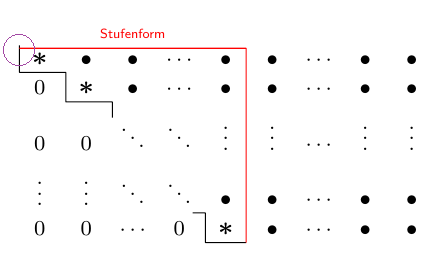|
Was muss ich machen, damit der Rahmen sauber anschließt?
\documentclass[varwidth, margin=5mm]{standalone} \usepackage[ngerman]{babel} \usepackage{amsmath, relsize, tikz} \usetikzlibrary{matrix, fit, positioning} \begin{document} \begin{tikzpicture}[ font=\footnotesize, rounded corners=0.125pt, ] % Einträge der Matrix \def\a{\mathlarger{\mathlarger{\boldsymbol{\ast}}}} \def\b{{\bullet}} % Matrix \matrix (m) [ matrix of math nodes, inner sep=0pt, column sep=0.25em, row sep=1pt, nodes={inner sep=0.25em,text width=1em,align=center}, ] {% |(oL)|\a & \b & \b & \cdots & |(oM)|\b & |(T1o)|\b & \cdots & |(T2o)|\b & |(oR)|\b \\ 0 & |(d22)|\a & \b & \cdots & \b & \b & \cdots & \b & \b \\ 0 & 0 & |(d33)|\ddots & \ddots & \vdots & \vdots & \cdots & \vdots &\vdots \\ \vdots & \vdots & \ddots & |(d44)|\ddots & \b & \b & \cdots & \b &\b \\ 0 & 0 & \cdots & 0 & |(uM)|\a & |(T1u)|\b & \cdots & |(T2u)|\b &\b \\ };% % Treppe % oben \draw[] (oL.north west) -- (oL.south west) -- (oL.south west-|d22.north west) -- (d22.south west) -- (d22.south east) -- (d22.south east-|d33.north west) -- ([yshift=1.5em]d33.south west); % unten \draw[] ([xshift=0.5em]d44.south) -- (d44.south-|uM.north west) -- (uM.south west) -- (uM.south east); % Rahmen \draw[red] (uM.south east) -- (oM.north east) -- (oM.north east-|oL.north west) node[midway, above, font=\tiny\sffamily]{Stufenform}; \end{tikzpicture} \end{document} |
|
Ich würde \documentclass[varwidth, margin=5mm]{standalone} \usepackage[ngerman]{babel} \usepackage{amsmath, relsize, tikz} \usetikzlibrary{matrix, fit, positioning} \begin{document} \begin{tikzpicture}[ font=\footnotesize, rounded corners=0.125pt, ] % Einträge der Matrix \def\a{\mathlarger{\mathlarger{\boldsymbol{\ast}}}} \def\b{{\bullet}} % Matrix \matrix (m) [ matrix of math nodes, inner sep=0pt, column sep=0.25em, row sep=1pt, nodes={font=\mathstrut,text width=1em,align=center}, ] {% |(oL)|\a & \b & \b & \cdots & |(oM)|\b & |(T1o)|\b & \cdots & |(T2o)|\b & |(oR)|\b \\ 0 & |(d22)|\a & \b & \cdots & \b & \b & \cdots & \b & \b \\ 0 & 0 & |(d33)|\ddots & \ddots & \vdots & \vdots & \cdots & \vdots &\vdots \\ \vdots & \vdots & \ddots & |(d44)|\ddots & \b & \b & \cdots & \b &\b \\ 0 & 0 & \cdots & 0 & |(uM)|\a & |(T1u)|\b & \cdots & |(T2u)|\b &\b \\ };% % Treppe % oben \draw[] (oL.north west) -- (oL.south west) -- (oL.south west-|d22.north west) -- (d22.south west) -- (d22.south east) -- (d22.south east-|d33.north west) -- ([yshift=1.5em]d33.south west); % unten \draw[] ([xshift=0.5em]d44.south) -- (d44.south-|uM.north west) -- (uM.south west) -- (uM.south east); % Rahmen \draw[red] (uM.south east) -- (oM.north east) -- (oM.north east-|oL.north west) node[midway, above, font=\tiny\sffamily]{Stufenform}; \end{tikzpicture} \end{document}
Wird einem die Matrix dadurch zu groß, kann man den Abstand der Zeilen beispielsweise mit Mmmh... ich habe
(22 Apr '17, 20:27)
cis
@cis Ich sehe da nichts von klobig. Ich habe ja im Gegenzug das
(23 Apr '17, 10:19)
saputello
Mir ist aufgefallen, dass mit
(23 Apr '17, 18:13)
cis
1
@cis Das ist logisch weil
(23 Apr '17, 21:06)
esdd
|


